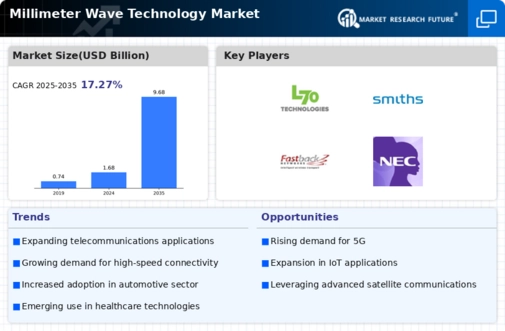Top Industry Leaders in the Millimeter Wave Technology Market

The Competitive Landscape of the Millimeter Wave Technology Market
The millimeter wave (mmWave) technology market, navigates the electromagnetic spectrum's high-frequency frontier. With its unique blend of high bandwidth, low latency, and directional beamforming capabilities, mmWave unlocks a treasure trove of opportunities across diverse industries, from blazing-fast wireless communication to high-precision radar systems. Grasping the competitive landscape in this dynamic market is crucial for players seeking to capitalize on its expansive potential.
Some of the Millimeter Wave Technology companies listed below:
- Millivision Technologies
- Vubiq Networks Inc.
- Smiths Group PLC
- Fastback Networks
- NEC Corporation.
- Mistral Solutions Pvt. Ltd
- E-Band Communications LLC
- Farran Technology Ltd
- L3 Technologies Inc.
- Millimeter Wave Products Inc.
Strategies Adopted by Leaders
- Technological Prowess: Leading players like Qualcomm, Samsung, and NXP Semiconductors invest heavily in R&D, pushing boundaries in chip design, antenna technology, and beamforming algorithms. They pioneer solutions like advanced phased array antennas, compact mmWave modules, and integrated circuits optimized for high-frequency operation, paving the way for efficient and cost-effective mmWave deployments.
- Application Focus: Players strategically cater to specific industry segments. Ericsson and Nokia excel in mmWave infrastructure solutions for 5G networks, while Keysight Technologies focuses on testing and measurement equipment for mmWave devices. This specialization allows for tailored technologies and deeper expertise in each sector's unique needs.
- Collaboration and Partnerships: Fostering close collaborations with network operators, device manufacturers, and system integrators accelerates innovation and broadens market reach. For instance, partnerships between chipset providers and smartphone manufacturers enable rapid adoption of mmWave-enabled devices.
- Global Footprint: Establishing a strong global presence is crucial for catering to the geographically diverse nature of mmWave deployments. Companies like Rohde & Schwarz and Analog Devices maintain robust sales and support networks across continents, ensuring customer proximity and efficient deployment support.
- Focus on Standardization and Regulations: Actively participating in industry standardization efforts and navigating complex regulatory landscapes is key for market acceptance and widespread adoption. Companies play a vital role in shaping mmWave technology standards and ensuring compliance with regional regulations.
Factors for Market Share Analysis:
- Frequency Bands: Analyzing market share by frequency bands (26 GHz, 39 GHz, etc.) reveals dominant players in each segment and future growth potential. Lower bands offer wider coverage but lower data rates, while higher bands offer blazing speeds but face challenges in penetration and range.
- Application Segment: Understanding the needs of different end-user segments (telecoms, automotive, industrial) is key. Telecom operators prioritize high-speed backhaul and fixed wireless access solutions, while automotive applications demand short-range, high-resolution radar systems. Players cater their solutions to meet these diverse requirements.
- Component Focus: Analyzing market share by component segments (chipsets, antennas, test equipment) helps identify leaders in each segment and emerging trends. Chipset advancements drive miniaturization and cost reduction, while antenna technology innovations improve beamforming accuracy and coverage.
New and Emerging Companies:
- Siklu Communication: This Israeli company specializes in high-performance mmWave radios for fixed wireless backhaul and point-to-point communication, catering to the growing demand for reliable and high-capacity wireless connectivity in remote areas.
- Eravant: This American company pioneers mmWave sensors for automotive applications, enabling advanced driver-assistance systems (ADAS) and autonomous driving functionalities. Their radar technology offers exceptional precision and object detection capabilities, enhancing safety and paving the way for self-driving vehicles.
- Nozomi Networks: This American company focuses on AI-powered security solutions for industrial control systems (ICS) utilizing mmWave technology. Their solutions offer real-time anomaly detection and threat identification, protecting critical infrastructure from cyberattacks and ensuring operational resilience.
Industry Developments:
Oct.25, 2022- Movandi, a leading provider of new 5G RF and millimeter-wave technologies and software, announced its collaboration with Rakuten Mobile to expand 5G millimeter-wave network coverage across Japan. Movandi's core 5G mmWave, smart repeaters, and BeamXR Open-RAN technology would enable Rakuten Mobile to extend and deploy its 5G network across Japan cost-effectively.
Movandi's proprietary mmWave RF chipsets and phased-array antenna technology & software enable 5G mmWave signals that can provide coverage beyond other mmWave approaches while reducing the cost of infrastructure. Its radios and smart repeaters deliver unmatched performance and cost & size advantages across high-frequency 5G millimeter waves and unlock the potential for new wireless multi-gigabit communication applications.
Oct.25, 2022- Marki Microwave, a radio frequency & microwave technology developer, announced the expansion of its millimeter wave/ mmWave portfolio with a range of edge mixers featuring integrated local oscillator (LO) drivers. Marki Microwave mmWave technologies deliver high performance across a wide bandwidth with reduced drive requirements. The integrated drive mixers reduce size, weight, power, and cost (SWaP-C) while simplifying the overall integration of the LO path for ease of use and optimized performance.
Sep. 30, 2022- Ericsson and O2 Telefónica announced that they have successfully demoed 5G wireless backhaul for rural and suburban coverage. The companies can deliver speeds up to 10 Gbps over 10 km and demonstrate fiber-like microwave connectivity.
The recent shift to remote working and work-from-home policy illustrated the need for fast & reliable connectivity in non-urban areas to respond to the challenges of maintaining telecom-grade availability beyond two to three kilometers. With the ability to deliver such high data speeds over more than 10 km, Ericsson & O2 Telefónica's technologies open up new possibilities for delivering low-latency, reliable broadband in harder-to-reach areas.
